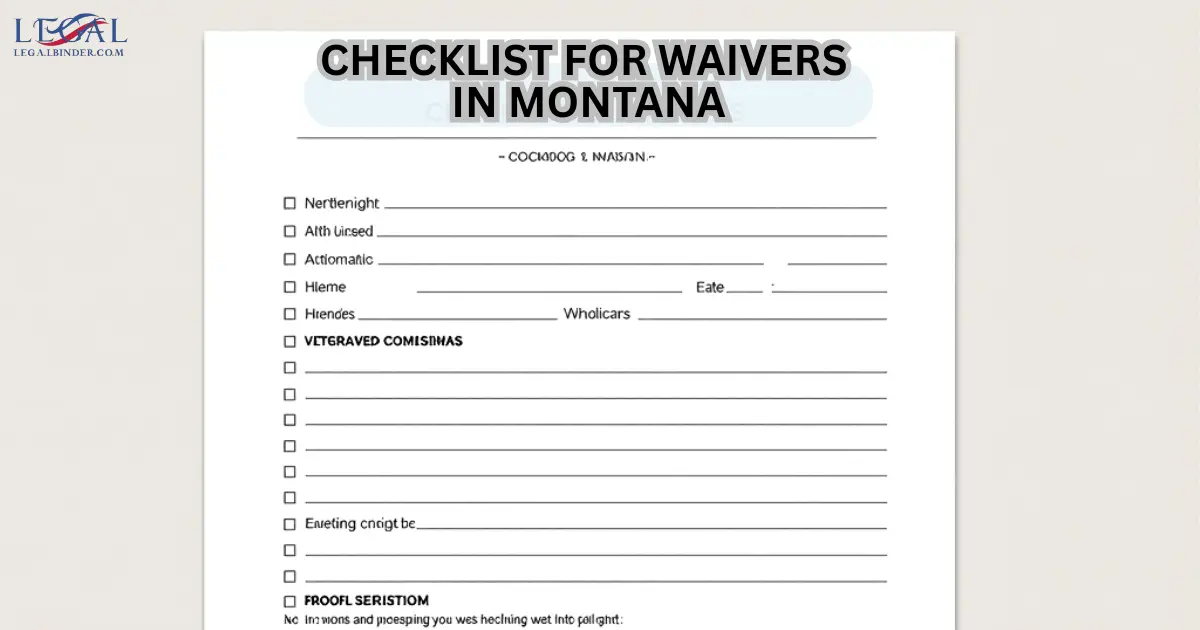This waiver Montana checklist shows what to prepare when you ask a Montana court to waive filing or appeal fees. Use this step-by-step guide to collect the correct forms, evidence, and filing details so your waiver request is complete and ready for the clerk or the judge.
The guidance below is tailored to Montana practice and references official Montana resources where you can download forms and verify procedures. If you need templates or related forms, visit the USALegalBinder.com home for state-specific resources and sample packets.
Quick overview — what this waiver covers (waiver Montana checklist)
A waiver in Montana usually refers to a request to proceed in forma pauperis or to have court fees, transcript costs, or copying charges waived because paying them would cause undue hardship.
Common requests include:
- Waiver of civil filing fees (District Court, Justice Court).
- Fee waiver for family court filings (custody, protection orders).
- Waiver of appellate filing fees or transcript costs for appeals to Montana Supreme Court or Court of Appeals.
State-specific requirements — Waiver Montana Checklist rules and agencies
Montana courts evaluate waiver requests on current income, assets, household obligations, and whether public benefits already cover basic needs. Key Montana agencies and sources you’ll rely on:
Residency: Montana residency is relevant where local court rules apply. Confirm the county clerk’s requirements where you will file.
Step-by-step: how to complete & submit a waiver in Montana
Follow these practical steps to prepare a waiver packet for filing in Montana courts.
- Identify the correct form. Visit the Montana Judicial Branch forms page and download the indigency/in forma pauperis affidavit or the specific motion required by the court handling your case.
- Complete the affidavit fully. Enter accurate gross income, household members, debts, and monthly expenses. Courts look for consistency and supporting evidence.
- Gather supporting documents. Attach benefit letters (Medicaid/SNAP), two recent pay stubs (if employed), bank statements (last 1–3 months), rent or mortgage receipts, and utility bills.
- Prepare a cover sheet and index. Add a one-page summary listing attachments — this speeds review by clerks and judges.
- Sign and, if required, notarize. Some Montana clerks accept sworn declarations without notarization; check local clerk instructions.
- File with the proper clerk or e-file. File at the county District Court clerk, justice court, or appellate clerk depending on the matter. Use Montana e-filing if available for your case type.
- Obtain a filed-stamped copy and monitor the docket. Keep proof of filing and check for any court order, hearing date, or request for additional documentation.
- If denied, respond fast. A denial may require fee payment to proceed; seek legal aid or request reconsideration promptly if you lack funds.
Typical attachments for a Montana waiver application include:
- Montana in forma pauperis affidavit or affidavit of indigency (Montana Judicial Branch form).
- Proof of public benefits from Montana DPHHS (if applicable).
- Recent pay stubs, employer letters, or unemployment statements.
- Bank statements (1–3 months), proof of rent/mortgage, and utility bills.
- Trust account statements for incarcerated filers.
Processing time, fees and deadlines Waiver Montana Checklist
There is no fee to submit a waiver application itself. Typical timing and practical tips for Montana filers:
- Decision time: Courts often rule within days to a few weeks, depending on workload and urgency.
- Effect on deadlines: File waiver requests early — appellate deadlines are strict and a late waiver may not extend filing windows.
- If expedited relief is needed: Emergency family matters or protection orders may be prioritized by Montana courts.
Common mistakes to avoid Waiver Montana Checklist
- Submitting incomplete affidavits or inconsistent income figures — double-check entries.
- Failing to attach documentary proof — unsupported claims are more likely to be denied.
- Using an outdated form — always download current Montana Judicial Branch forms from courts.mt.gov.
- Missing appellate deadlines when relying on a pending waiver — file early and request guidance if timelines conflict.
Use these authoritative Montana sources for forms and procedural guidance:
FAQs
Q: Does receiving Montana Medicaid guarantee a fee waiver?
A: Enrollment in Montana Medicaid or other public benefits is strong evidence of indigency but not an automatic waiver. The court will consider overall finances.
Q: Can an incarcerated person file for a waiver in Montana?
A: Yes. Incarcerated filers should attach the jail or prison trust account statement and follow the facility’s filing procedures.
Q: What happens if my waiver is denied?
A: A denial typically requires payment of the fee to proceed. Contact Montana Legal Aid or a local law clinic immediately for options like reconsideration or assistance in paying fees.
Q: Are waiver rules different for family court cases?
A: Procedures are similar, but family matters involving safety or custody may be expedited. Always check county family court clerk instructions.
Q: Where can I get free help preparing a waiver packet in Montana?
A: Reach out to Montana legal aid providers or law school clinics. County clerks can explain filing mechanics but not legal advice; for help, search Montana legal aid contacts or visit Montana Judicial Branch for local clerk info.
Conclusion & call to action
Use this waiver Montana checklist to assemble a complete, clear waiver packet: correct Montana Judicial Branch forms, benefit letters from DPHHS if applicable, income documentation, and a concise cover index will improve review speed. File early, get a filed-stamped copy, and monitor the docket.
For official Montana forms and updates visit the Montana Judicial Branch and verify benefits at Montana DPHHS. If you need legal assistance, consult a licensed Montana attorney or legal aid provider. For related templates and sample packets, see the resources on USALegalBinder.com.
